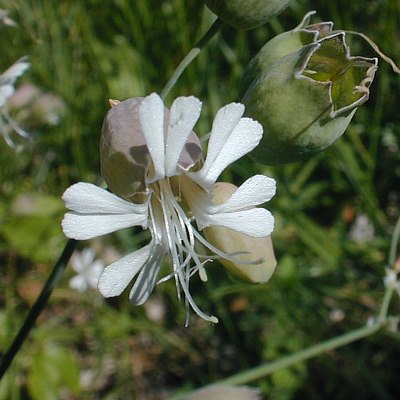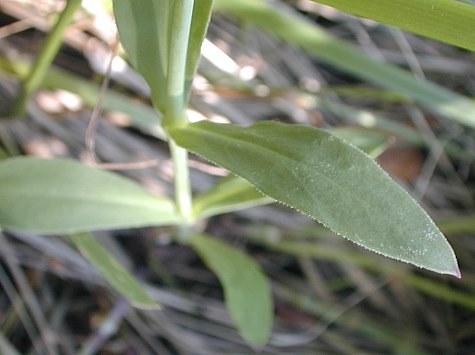Description: This herbaceous perennial plant is about 2' tall, often branching near the base. The stems are pale green, terete, and usually hairless. The opposite leaves are up to 2½" long and ¾" across, sessile against the stems, and pale green to grayish green. They are usually oblanceolate, but sometimes lanceolate or elliptic. Their margins are smooth and slightly ciliate, otherwise the leaves are hairless to sparsely pubescent.

Some of the upper
stems terminate in large panicles of numerous flowers. Each flower
is ½-¾" across and ¾-1" long, consisting of 5 white petals
that are deeply cleft (resembling 10 petals), a bladder-like
calyx that is pale green to dull pink, 10 exerted stamens, and
a pistil. The lobes of the cleft petals are narrowly oblanceolate. The
swollen calyx is ovoid, hairless, and about ¾" in length; it
has 20 longitudinal veins across its surface that are connected by a
reticulated network of smaller veins. Compared to the calyx, the veins
are a deeper shade of green or pink. The upper rim of this calyx has 5
broad triangular teeth. While in full bloom, the entire plant has a
tendency to lean over to one side because of the weight of the flowers.
The blooming period is usually early to mid-summer, and it lasts about
1-2 months. Each flower is replaced by an ovoid capsule that is open at
the top; it contains
small brown seeds. The root system consists of a taproot with short
rhizomes. This plant can spread clonally.
Cultivation:
The preference is full to partial sun, mesic to dry-mesic conditions,
and calcareous soil containing some gravel or sand.

Range
& Habitat: Bladder Campion
occurs occasionally in the northern half of Illinois,
while it is apparently rare or absent in the rest of the state (see Distribution
Map).
This plant is native to Eurasia, and it was first
observed in Illinois during the late 19th century. Bladder Campion was
probably introduced into the United States as a horticultural plant
because of the attractive flowers. Habitats include disturbed grassy
areas in various waste areas, including vacant lots, abandoned fields,
and areas along railroads. This plant also adapts to disturbed sandy
areas where there is scant vegetation, including middle to upper
beaches along Lake Michigan.
Faunal Associations:
Long-tongued bees pollinate the flowers; the flowers may attract moths
as well. Two insect species that have been introduced from Europe, Cassida azurea
(Neon Tortoise Beetle) and Cassida
flaveola (Pale Tortoise Beetle), feed on the foliage,
buds, and flowers of Bladder Campion. Because the foliage contains
saponins, mammalian herbivores usually avoid this plant. However, in
overgrazed pastures, livestock may eat this plant when little else is
available.

Photographic
Location:
A partially shaded area along a railroad in Urbana, Illinois.
Comments:
Bladder Campion is an attractive plant while it is in bloom. It
can be distinguished from other white-flowered Silene spp.
primarily by the appearance of its swollen calyx: This calyx has a
complicated network of veins and it is frequently dull
pink. For other white-flowered Silene spp.,
the calyx is usually more green and slender, and there are fewer
conspicuous veins along its length. Another unusual characteristic of
Bladder Campion consists of its deeply cleft petals, whereas other
similar species typically have shallowly cleft or notched petals.
Sometimes the hairiness of foliage (or its lack) provides another guide
to identification in this genus. For example, Silene
pratense (Evening Campion) has very pubescent foliage, while
the foliage of Bladder Campion is hairless or sparsely pubescent. An
older scientific name of Bladder Campion is Silene cucubalus.